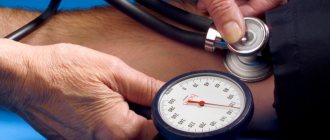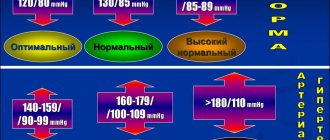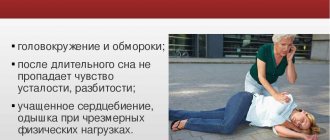Blood pressure 140 over 90
A blood pressure of 140 over 90 is called borderline hypertension.
With age, this pressure steadily increases, and the risk of developing heart disease increases accordingly. People with blood pressure of 140 over 90 should regularly measure it with a tonometer in order to prevent further increases. For pressures above these numbers, drug treatment is usually prescribed.
Causes of pressure 140 to 90
A blood pressure of 140 over 90 is the basis for a diagnosis of arterial hypertension. There are many causes of high blood pressure. In 90% of cases, the exact cause of hypertension cannot be determined. In this case, a diagnosis of essential hypertension is made.
In other cases, the reasons for the increase in pressure to 140 to 90 and above may be:
- Obesity. Every kilogram of excess weight increases blood pressure by 1 mmHg. That is, an extra 20 kg will lead to guaranteed hypertension.
- Pathological processes in the body. For example, high blood pressure often accompanies kidney disease.
- Age. Arterial walls lose elasticity over the years, vascular resistance to blood flow increases, and pressure increases.
- Hereditary predisposition.
- Smoking.
- Floor. Men are more susceptible to hypertension. Increases in blood pressure in women are prevented by the sex hormones estrogens.
- Fatty and salty foods.
- Alcohol abuse.
- Physical inactivity.
- Constant stress.
- Heart defects.
- Increased adrenaline levels in the blood.
- Constant use of hormonal contraceptives.
- Complicated pregnancy. For example, late toxicosis.
Treatment with folk remedies
- yarrow;
- dried marsh flower;
- Sophora japonica;
- large plantain;
- mistletoe;
- peppermint;
- horse chestnut;
- viburnum;
- calendula officinalis;
- valerian officinalis;
- Adonis spring.
Drug therapy
The essence of this type of treatment is the prescription of antihypertensive drugs. They help remove excess fluid from the body, dilate blood vessels and thereby reduce blood pressure. Drugs to lower blood pressure are divided into five large groups:
- Diuretics (“Furosemide”, “Indapomide”). They help remove fluid from the body, thereby reducing blood pressure. Diuretics are divided into: #8212; Thiazide. The safest and cheapest diuretics. Their disadvantage is that in addition to water and sodium, thiazides remove potassium from the body, which is extremely important for the functioning of the heart. Therefore, these drugs are contraindicated for people with low potassium levels.
- loopback These are powerful diuretics designed to urgently lower blood pressure. It is not recommended to use them on an ongoing basis. The most famous representative of this group of diuretics is Furosemide.
- potassium-sparing diuretics. Indicated for use in patients with low potassium levels in the blood.
The main disadvantage of adrenergic blockers is the large number of side effects that may occur when taking them. Therefore, only a doctor should prescribe these drugs.
The following criteria will help you understand how effectively hypertension treatment is going:
- Good patient tolerance of the proposed therapy.
- Reduction of upper and lower pressure levels to normal.
In modern medicine, not one, but several drugs are prescribed for the treatment of arterial hypertension. They have different mechanisms of action and accordingly affect all causes of high blood pressure.
Risk of complications
A pressure of 125 over 95 very rarely causes the development of dangerous complications, since it is normal and in a healthy person is not capable of causing vascular ruptures or other hemodynamic disorders. Frequent increases in blood pressure indicate the development of vegetative-vascular dystonia and disruption of the nervous system responsible for vascular tone. If you seek qualified medical help and change your lifestyle, an increase in blood pressure to such values goes away on its own, but sometimes requires specific antihypertensive therapy.
Pressure 130 over 90 - normal or the beginning of the disease
Enter your pressure
130
on
90
Search in progress Not found
Blood pressure (BP) is the pressure of blood in all the arteries of our body. Since there are a sufficient number of arteries in the human body, and therefore the pressure in each of them is different from each other, it was decided to measure the total or average pressure in the brachial artery, that is, near the elbow, as is still done to this day.
For an adult who has crossed the 35-year-old threshold, the norm is considered to be from 120/80 to 139/89 (normal elevated), that is, a pressure of 130 over 90 cannot be a serious defect. If there are visible deviations, you should not immediately panic, since, in addition to the state of health, a person’s blood pressure is also influenced by external factors. For example, with a person’s normal blood pressure being 120/80, the pressure is 130/90, that is, a slight increase in blood pressure, which may be associated with heavy physical or sports activities. In hot weather it usually drops by several points, this is normal.
What do the numbers showing pressure mean?
Probably everyone knows that the first number, or upper pressure, is the pressure of the heart, and the second, or lower pressure, is the pressure of the kidneys. That is, a pressure of 130 over 90 means that 130 is the force with which the heart pushes blood into the vessels, and 90 is the pressure level of the blood fluid at the moment of maximum relaxation of the heart muscle. Exceeding the lower pressure mark of 80 divisions most often indicates some kind of kidney disease.
What affects pressure surges?
In addition to the fact that blood pressure is influenced by the work of the heart and kidneys, as well as external irritating factors, special attention should be paid to the fact that blood pressure levels also change with age. If for a young person the norm is 100-120 per 65-80, then for a person who has crossed the 50-year mark it is already 135 per 90
The standards that were approved by WHO state that the best, or optimal blood pressure is 120/80, 130/85 is considered normal, but 140/90 is already elevated. The latter indicator indicates the presence of the first, or mild stage of hypertension. That is, people whose blood pressure is 130 over 90 should already think that it’s time to visit the clinic for a routine examination.
Let's look at the same indicators that were announced by WHO, because no less interesting figures were presented here. Initially, it is worth saying that hypertension is divided into three types - mild, moderate and severe. So, a sign indicating the onset of the disease or the first stage of hypertension is pressure 140-159/90-99, that is, people whose pressure is 130 to 110 are definitely not hypertensive, but lower pressure should cause concern, indicating on the condition of the kidneys. With moderate hypertension, blood pressure can fluctuate between 160/100 and 179/109. In this case, drug treatment is simply necessary, since this threatens not only the transition of the disease to the last stage, but also more serious problems. Well, it is quite clear that severe hypertension is the correct diagnosis for those whose blood pressure sometimes rises above 180/110. In this case, turning to specialists is a chance to save your life!
Hypotension is low blood pressure. A 50-year-old person whose blood pressure is 130 over 100, for example, simply shouldn’t talk about hypotension. A sign of this disease is considered to be a drop in pressure to a level of 90 to 60. In this case, a person feels irresistible fatigue, drowsiness, gets tired quickly and may experience headaches. Naturally, in this case you also need to contact a specialist.
What does a pressure of 120 to 80 mmHg mean? Art.
Doctors established the blood pressure standard “120/80” based on the results of examination of astronauts during and after high loads. What does a blood pressure reading of 120 over 80 mean on a tonometer? It depends on the person’s age.
In newborns, infants and children under 10 years of age, this level is considered a sign of hypertension. In adults and elderly patients, this value is considered the best for the cardiovascular system, blood supply to the brain and internal organs.
What do heart rate and blood pressure indicators mean:
| Name | Explanation |
| The first number is systolic (upper) pressure | The number indicates the force of blood ejection from the ventricles of the heart at the moment of contraction of the organ |
| The second number is diastolic (lower) blood pressure | The number indicates the degree to which the heart ventricles are filled with blood at the moment the organ relaxes |
| The third digit is heart rate (pulse) | The number indicates the number of myocardial contractions per minute |
Prevention and treatment
If a person’s blood pressure was recorded at this level and he became ill, it is necessary to take measures to reduce it.
Further actions should be aimed at determining whether 130 to 80 is normal or not. So for this it is worth measuring blood pressure for 7 days in a row in a calm physical and mental state. Whatever indicators are revealed during a given period, this will be the result.
Prevention of hypertension
If blood pressure is 130 over 80 normal for a person, there is no need to do anything, but if it is elevated, it is better to start with prevention:
- Give up bad habits such as smoking and drinking alcohol.
- Stop drinking strong black tea or coffee.
- Use table salt in minimal quantities, which also includes avoiding lightly salted fish, seafood, smoked meats, etc.
- Lose excess weight, if any.
- Avoid nervous tension and stressful situations.
- Normal sleep and proper rest.
- Balanced nutrition, diet.
- Moderate physical activity.
What to do if hypertension is confirmed? - Get treatment! It consists of medications that lower blood pressure levels.
There are a huge number of them in tablets, drops, injections. They lower blood pressure with different intensities and are suitable for patients in different ways. What works for you specifically may not help someone else at all.
Blood pressure 130-131-132-133 at 80-85 is not critical, therefore it is lowered by the simplest antihypertensive drugs (Corvalol, Piracetam, Captopril, Enalapril, Papazol, etc.).
Photos of medicines:
How to lower high blood pressure at home if there are no special pills? Many people are helped by the usual No-shpa, chokeberry, and a walk in the fresh air.
Blood pressure norms
Each organism is individual and it is not worth applying the standard to absolutely everyone. Blood pressure norms are most likely a generalization, and it is reasonable to apply them in practice only to completely healthy people.
Many diseases can cause an increase in blood pressure, which should always be taken into account, because to eliminate hypertension you need to get rid of the root cause.
The most optimal blood pressure readings for a healthy person, also called space pressure, are 120 over 80. If this is your constant blood pressure, then you can safely fly into Space. However, for some people, even this pressure can cause headaches. To a greater extent, they belong to the category of hypotensives, that is, individuals with naturally low blood pressure.
Also, medical observations established the “ideal” lower - from 110 to 70, and the upper - up to 130 to 85, boundaries. So, if the pressure is within these limits, no problems that are inherent in hyper- or hypotensive patients should arise.
Whether a blood pressure of 130 over 80 is normal for a particular person is also determined by the heart rate. The pulse should not be less than 60 beats per minute or more than 80.
If there are obvious deviations from the indicated indicators, we can talk about increased or decreased blood pressure.
What is blood pressure
Even the immortal hero of Petrov and Ilf Ostap Suleiman Bertha Maria Bender-Zadunaisky subtly noted that “every citizen is pressed by a column of air with a force of 214 kilos.” To prevent this scientific and medical fact from crushing a person, atmospheric pressure is balanced by blood pressure. It is most significant in large arteries, where it is called arterial. The blood pressure level determines the volume of blood ejected by the heart per minute and the width of the vascular lumen, that is, resistance to blood flow.
- When the heart contracts (systole), blood is pushed into the large arteries under pressure called systolic. Popularly it is called the upper one. This value is determined by the strength and frequency of heart contractions and vascular resistance.
- The pressure in the arteries at the moment of cardiac relaxation (diastole) gives an indicator of the lower (diastolic) pressure. This is the minimum pressure, completely dependent on vascular resistance.
- If you subtract diastolic blood pressure from systolic blood pressure, you get pulse pressure.
What is normal blood pressure and what is high blood pressure?
Most people will immediately answer this question: normal blood pressure. of course, this is 120 by 70 mmHg. Blood pressure above 120/70 is considered elevated.
Right? Yes and no. The numbers 120/70 are really good, ideal pressure. In the event that you are young, if you are 20 years old, you do not have an ounce of excess weight, and if you are training to be an astronaut.
But if you are 30-35 years old, or a little overweight, or don’t move much, then your normal blood pressure is 130/80. Although 120/70 is also good, even better. But there is absolutely no need to worry about the difference of plus or minus 10 units.
Well, what about the terrible 140/90? Is this a lot or not?
At 20 years old, 140/90 is really too much. This indicates a tendency to high blood pressure, a tendency to hypertension. But this is not a disaster yet. I repeat, at 20 years old 140/90 is only a harbinger of possible future troubles.
But at the age of 40 and older, 140/90 is the norm! Normal pressure! Moreover, this is the ABC, they teach this in the second year of medical school!
After all, over the years, blood pressure increases in almost any person, especially if he is not a blessed Buddhist monk living high in the mountains. And already in the second year of medical institutes, future doctors are taught that starting from the age of 40-45, blood pressure is considered normal: 130/80 - 140/90.
And you need to reduce the pressure only if it has risen above 150/90 or 150/100.
Apparently, someone is studying at the institute carelessly. Or too zombied by representatives of pharmaceutical companies. And, having become a doctor, the former student forgets about what he was taught in medical school.
“Oh,” he says to his 50-year-old patient, “your reading is 140/90, you need to take pills urgently.” Otherwise, horror, horror, horror!
Let me clarify. Because of 140 to 90 there will be no horror. None. And there is no need to knock down 140/90. And it’s not even necessary to knock down 150/90. Especially if your body tolerates them calmly.
Now, if the pressure has risen to 160, and especially if it continues to rise, it is worth taking action. But you don’t have to take pills right away; there are other options. We will talk about them below.
In the meantime, let’s answer the following question (even several questions at once):
Are you sure you know your blood pressure? Are you sure you know how to measure blood pressure correctly? And doctors - do they always measure blood pressure correctly? Somehow we got too many questions at once. Not good. Let's try to summarize all these questions into one:
From the book of Dr. Evdokimenko BEING HEALTHY IN OUR COUNTRY.
All important articles about hypertension and high blood pressure
The first chapters of the book Being healthy in our country
All articles by Dr. Evdokimenko
Blood pressure 125 over 80, 85 – is this normal or not?
Update date: 09/07/2019
Normally, a healthy person's blood pressure should be 120 over 80.
This pressure is an indicator of good functioning of the cardiovascular system.
If the numbers increase or decrease, then there is a risk of pathologies with the heart or blood vessels.
An increase in tonometer numbers to 125 to 80 or 85 is not an indicator of high blood pressure, but may indicate the appearance of the first signs of a disease. At the same time, this may be a variant of the norm, which depends on many factors.
Letters from our readers
The danger of this condition
A blood pressure of 125 over 80 or 85 is not a dangerous condition. It may vary depending on the time of day, physical activity, ambient temperature or a person’s lifestyle.
However, high blood pressure may indicate a problem with the cardiovascular system. An increase in blood pressure readings may be the first sign of arterial hypertension. This, in turn, increases the risk of heart attacks and strokes.
Subsequently, a pressure of 125 to 80 can turn into more severe conditions, which are accompanied by an increase in readings to 140/90 and higher. Such figures already indicate stage 1 hypertension.
How does a person feel?
An increase in blood pressure is always accompanied by a number of symptoms. If the numbers change by 5-10 units, symptoms may be less pronounced or completely absent.
If the numbers change by 10 units or more, then signs appear that can cause serious discomfort or even restrictions on normal life activities.
The main manifestations of pressure 125/80 include:
- chest pain;
- headache, mainly in the back of the head;
- fatigue;
- vision problems;
- labored breathing;
- arrhythmia;
- blood in urine.
A physiological increase in blood pressure does not cause any symptoms. If any disease occurs that causes high blood pressure, the above symptoms will manifest themselves and cause discomfort.
Causes
The causes of increased pressure can be both physiological and pathological. Physiological ones include:
Pathological causes indicate the presence of a disease, including:
- obesity and overweight;
- diseases of the cardiovascular system;
- chronic kidney disease;
- disruption of the adrenal glands and thyroid gland;
- apnea.
In addition to general reasons, there are categories of people in whom the error in indicators can be either a variant of the norm or a manifestation of a disease. These include pregnant women and the elderly.
How to normalize
It is necessary to reduce the pressure from 125 to 80 or 85 only if it is caused by pathological reasons and can lead to complications or is observed in a hypotensive person. And also, if accompanied by unpleasant symptoms that interfere with normal life.
Normalization of pressure includes several stages:
- You need to check the readings again. Perhaps the measurement was taken incorrectly.
- You should relax and lie down. The head should be higher than the level of the heart; a reclining position is ideal.
- Provide oxygen access. Unbutton your collar and open the window.
- Apply a cold compress to the back of your head.
- You can take a hot foot bath, it will improve blood circulation to the periphery.
This is where first aid ends. If the pressure has not decreased within 20-30 minutes after the start of assistance, you should consult a doctor. He will examine the patient and prescribe, if necessary, the necessary medications.
It is very important not to use medications that lower blood pressure on your own, as they can lead to loss of consciousness or coma.
Therapy with a doctor
Increased blood pressure can occur both due to an incorrect lifestyle and due to the appearance of any diseases.
You should consult a doctor if the cause of pressure 125/80 is any disease, or the accompanying symptoms are life-limiting.
If the indicators change after drinking coffee, alcohol or smoking, there is no need to consult a doctor, since the cause was a physiological effect on the body.
The doctor diagnoses and prescribes treatment depending on the root cause of high blood pressure. Treatment typically includes regular exercise, a low-salt diet, and medication.
Drug therapy
There are several types of drugs that are used to treat blood pressure of 125 over 80 or 85. These include:
- Angiotensin-converting enzyme (ACE) inhibitors. They improve heart function and reduce blood pressure.
- Angiotensin receptor blockers. They have vasodilating properties.
- Diuretics. Remove excess salt from the body, relieve swelling.
- Beta blockers. Reduces heart rate, lowers blood pressure.
- Calcium channel blockers. Prevents the absorption of calcium into the heart muscle.
- Alpha blockers. Dilate blood vessels.
- Alpha agonists. Reduce the level of renin, which regulates blood pressure.
- Renin inhibitors. Reduce blood pressure and dilate blood vessels.
- Combined drugs. They can have a beneficial effect on the heart, dilate blood vessels and reduce renin levels.
Diuretics are usually the main treatment. They gradually normalize blood pressure and have few side effects.
However, your doctor may prescribe other medications to treat the specific condition that is causing your blood pressure to rise. For example, ACE inhibitors are very widely used in diabetes. If some medications do not help, then alternative medications may be prescribed for treatment.
Home treatment
High blood pressure is sometimes called the “silent killer” because it may not cause any symptoms but can wreak havoc on the body. Therefore, it is very important to follow home treatment to avoid complications such as stroke or heart attack.
Comprehensive home treatment includes:
- Physical exercise. 30 to 60 minutes of activity is essential for maintaining a healthy lifestyle. Along with this, blood pressure normalizes and body weight decreases. You need to start training gradually, increasing the load.
- Low salt diet. The basis of the diet should be vegetables, fruits and whole grains. Meat, fish and dairy products should be lean and cooked without salt, preferably steamed or baked. Sweets, carbonated drinks, juices and animal fats are strictly limited.
- Using herbs instead of salt. As a rule, many spices already come with salt, so you should pay attention to the label. Provencal or Italian herbs, as well as basil, oregano, dill and parsley, are well suited for cooking.
- Losing excess weight. Excess body weight affects the heart and other organs, so losing weight is important. This will reduce the risk of serious diseases.
Blood pressure 80/60 what to do
When the pressure is below 100/60 mm Hg. Art. It is generally accepted that a person has a hypotonic state resulting from a physiological or pathological change. Moreover, age does not matter in this case: low blood pressure occurs in both elderly and young people. Let's take a closer look at the causes of low blood pressure.
Can low blood pressure be an individual norm?
It is not uncommon for people under 30 to often have low blood pressure (for example, 90/60 mmHg). It is interesting that a person’s well-being may be normal; weakness and dizziness will not be felt. In addition, for many people, blood pressure may drop sharply after strong emotional experiences or when exposed to adverse weather conditions. In such cases, a person experiences weakness, drowsiness, nausea, pain and dizziness.
Do you recognize similar symptoms? What to do if your blood pressure is low? The very first action is to drink a cup of strong sweet tea or coffee and eat a sandwich. You can take a painkiller for your head. A short contrast shower helps many people, but you also need someone else next to you. When drinking coffee, monitor your condition, because after a short increase in blood pressure, an even greater decrease may occur. Then it is advisable to go to bed. As you know, caffeine activates the body’s internal reserves at the expense of the body itself, so exhaustion may soon occur.
Constantly low blood pressure
If there are more frequent attacks of unexplained weakness, drowsiness in the middle of the day, headache attacks, inability to concentrate, and if at the same time blood pressure is reduced, it’s time to take your health seriously. Do not hesitate to consult a doctor, because all of the above symptoms are signs of primary hypotension
There is no need to pretend that you do not notice this, because these are signals from the body about a violation of vascular tone. If such problems are not treated in time, then after about 40 years there is a chance to turn from an ordinary hypertensive patient into a severe one. And even a stroke cannot be ruled out in the future.
Do not hesitate to consult a doctor, because all of the above symptoms are signs of primary hypotension. There is no need to pretend that you do not notice this, because these are signals from the body about a violation of vascular tone. If such problems are not treated in time, then after about 40 years there is a chance to turn from an ordinary hypertensive patient into a severe one. And even a stroke cannot be ruled out in the future.
Please note that you will definitely need a face-to-face consultation with a specialist, and not a banal medication that you prescribe for yourself. In case of severe weakness and fainting conditions, it is advisable to support the body with medicinal herbs. Buy tinctures of lemongrass, ginseng, Leuzea, and Rhodiola rosea at the pharmacy. These tinctures must be taken for 3 weeks, after which take a break of 1 month. Herbs can have a tonic effect on the vascular system.
headache pressure 115 over 80
Found (21 posts)
therapist December 3, 2014 / MXX / Ryazan
... feels normal. But to maintain such pressure
takes blood pressure pills every day... after 2-3 days,
the pressure
began to drop to
115 over 80
in the first half... she feels nauseous, weak, dizzy and
has a headache
. By 4 pm
the pressure
rises to 140... open
neurologist February 5, 2014 / Alexander... / Kyiv
Good afternoon. My wife (27 years old) has had
a headache
(acute pain near the right temple) and slight nausea.
The
pressure
is
normal (
115-120 to
75-80 ). Is this possible due to the delay after washing my hair? What... open
therapist January 1, 2014 / Andrey / Chelyabinsk
… 20 years. For the third day in the afternoon, I have had
a headache
in the forehead area, in the upper right corner, that is, as if perpendicular to the right eyebrow.
The average
blood pressure is 115
-70, the pulse is about
80
...
There is no swelling at
neurologist January 1, 2014 / Andrey / Chelyabinsk
… Day! For the third day in the afternoon, I have had
a headache
in the forehead area, in the upper right corner, that is, as if perpendicular to the right eyebrow.
The average
blood pressure is 115
-70, the pulse is about
80
...
There is no swelling at
vascular surgeon December 2, 2011 / Oksana
Hello! Mom, 54 years old, had an attack on September 28: nausea, short-term loss of consciousness, fell. The ambulance pumped out: phenazem injection, magnesium, glycine. Pressure 150 over 100. ECG... open
June 2, 2013 / Irina
... concentric isochogenic plaque, stenosing the lumen at
40% by area. More variable... 01) Triglyceride 0.910 (0.565-1.695).
Pressure 115
-70, after physical activity... intoxication in the head. No dizziness,
no
headache .
Sometimes (extensive physical activity...
neurologist May 20, 2012 / Anonymous / 0
… wrong address. I’ve had
a headache
, not all over, but in the back of my head, and not all the time... sometimes to the point of nausea and it goes away on its own.
Pressure
110-115
-
80
. But I was worried because... somehow myopia suddenly developed - I read,
on
the computer without glasses, but then... open
gynecologist April 1, 2012 / Olga
… . and somehow I accidentally measured my blood pressure
and it turned out to be 150/100.
although before my blood pressure
was always 120./115
over 80/70 (
didn’t go higher), it’s been like a week now... using Tri-Regol after a year, I feel great except for
a
headache open
cardiologist July 8, 2011 / Sashka / 0
... it hurts
in the area of the heart,
headache
, dizziness, trembling in the body, all trembling,
pressure 115-120
per
pulse be
of 80-90
my heart was not beating evenly , intermittently. ... open
neurologist February 10, 2011 / Katerina... / Chisinau
... I seem to feel better, the doctor measured my blood pressure
115/70
, temperature 36.6, they gave me ... I can’t concentrate, my vision doesn’t focus well,
my head
periodically goes numb, I often want to sleep, ... I want to sleep again, even in the morning
hurts
, the temperature “runs” from 36.7 ... open
03-Ambulance April 24, 2010 / Polina / Omsk
... for a week, every day I have
headache
. The pain starts from the back of the neck. About 3 years ago I had
a headache
, but not so often, I went to the doctor ... There is pressure in the scales,
hurts
, in general my whole
head
is pounding.
Pressure 115 over 80.
Tell me what it is... open
Treatment
If a person has high blood pressure and a very bad headache, taking the first pill that comes to hand is not only useless, but also extremely dangerous. Each drug acts in its own way: normalizes blood circulation, relaxes spasmodic blood vessels, relieves pain and relieves inflammation. Therefore, what to do if the victim has high blood pressure, feels nauseous and has an unbearable headache, the doctor decides after conducting diagnostics and establishing an accurate diagnosis.
Medicines for hypertensive patients are divided into several types.
Selective beta blockers
These are new generation drugs that allow you to avoid many of the side effects caused by old drugs. They reduce the heart rate, normalize blood flow, which prevents cardiovascular diseases. Well proven:
- Atenolol.
- Biprolol.
- Tenoric.
- Metoprolol.
Calcium channel blockers
These drugs interfere with the penetration of calcium into the arteries and vessels, working to relax the coronary muscles and expand the lumens. Many people experience high blood pressure and headaches due to excess calcium ions, which causes spasm of smooth muscles, which leads to the development of heart disease or microinfarction. Calcium channel blockers do not cause side effects and do not negatively affect the respiratory system.
Among the most famous are:
- Verapamil hydrochloride.
- Nifedipine.
- Isoptin.
- Finoptin.
- Cinnarizine.
Myotropic antispasmodics
Their action is very similar to calcium blockers, but they are used at the onset of the disease. Drugs such as: relieve muscle spasms and promote vasodilation:
- Drotaverine.
- Hydralazine.
- Bendazole.
- Magnesium sulfate.
- Papaverine.
ACE inhibitors
They expand the lumens of blood vessels, stabilizing the patient's condition. Usually well tolerated and prescribed for the treatment and prevention of cardiovascular diseases. They can be combined with other medications. This:
- Renitek.
- Enap.
- Tarka.
Diuretics
Sodium and calcium are removed from the body in the urine. As a result, a severe headache should go away due to a decrease in blood circulation and a drop in blood pressure. This:
- Furosemide.
- Lasix.
- Trifas.
Nitrates
They sharply reduce blood pressure, which requires great caution when taking. These drugs respond well to the treatment of first-degree angina and myocardial infarction:
- Erinith.
- Isoket.
- Sustonite.
Alpha blockers
Spasms in blood vessels are quickly relieved due to the neutralization of the effect of adrenaline on pain receptors. They are not used for neurological diseases, angle-closure glaucoma, acute heart failure:
- Arfonad.
- Kamiren.
- Ditamin.
- Omnic.
- Ebrantil.
Sartans (BRA)
Eliminate oxygen starvation of tissues without affecting the functioning of the heart. Sartans are often used in cardiology, considered a group of promising drugs:
- Eprosartan.
- Valsartan.
- Telmisartan.
- Losartan.
- Candesartan.
Analgesics
They help when the hypertensive headache remains, but the pressure is already normalized. These medications are based on analgin, which is not recommended for elderly patients.
The most famous analgesics:
- Citramon.
- Paracetamol.
- Sedalgin.
- Has
- Moment.
Tranquilizers
Cause minor side effects. Used for anxiety, nervousness, restlessness. These drugs eliminate excessive sweating, chills, dry mouth, and attacks of pain in the head. These include:
- Valium.
- Phenazepam.
- Xanax.
Blood pressure 130 over 90 tactics of patient and doctor
Many people believe that normal blood pressure is 120 over 80. Is this true? And what to do if the tonometer shows 130 to 90? Is this hypertension? Should I take blood pressure pills?
Do not swallow the pills right away. There are other options to solve the problem. And if you still have to take pills, then they should be prescribed by a doctor, taking into account age, indications/contraindications, degree of increase in blood pressure, concomitant diseases, etc.
Blood pressure classification
According to WHO recommendations, the upper limit of normal blood pressure (BP) in people under 40 years of age is considered to be 139 over 89. That is, with indicators of 140 over 90, we can already talk about arterial hypertension (AH) 1st degree. If systolic (SBP) and diastolic blood pressure (DBP) are in different categories, then the presence and degree of hypertension is judged by a higher indicator. Therefore, a pressure of 130 over 90 also indicates stage 1 hypertension.
However, this classification is valid only when blood pressure is measured by a health care worker (the so-called clinical or office). When determining the pressure yourself at home, the criteria for diagnosing hypertension will be different: the threshold in this case is a pressure of 130-135 over 85. That is, a blood pressure of 140 over 90 at a doctor’s appointment approximately corresponds to a “home” blood pressure of 130-135 over 85. And in In this case, a pressure of 130 over 90 will be regarded as elevated. These indicators are largely arbitrary, but their use facilitates the diagnosis and treatment of hypertension.
In addition, elevated blood pressure does not always indicate hypertension. It may be caused by vegetative-vascular dystonia and/or be situational in nature, i.e. provoked by psycho-emotional and physical overload, atmospheric phenomena, heavy smoking, overeating (especially at night), abuse of products that increase blood pressure (alcohol, salt, coffee, chocolate, cheese, etc.).
Risk factors for hypertension
If the doctor nevertheless diagnosed hypertension of the 1st stage. this does not mean that the patient should immediately start taking medications for high blood pressure. In the absence of the following risk factors:
- family history of early cardiovascular pathology;
- in men over 55, women over 65;
- hyperlipidemia;
- abdominal obesity;
- impaired glucose tolerance;
- smoking,
or if 1-2 of them are present, the patient receives recommendations for optimizing lifestyle and is observed by a local therapist for several months (in the first case) or weeks (in the second).
Lifestyle modification measures
- Rejection of bad habits.
- Weight loss.
- Increasing physical activity.
- Increasing the consumption of foods of plant origin and reducing animal fats and table salt.
- Learn to cope with stressful situations, relieve psycho-emotional stress.
Lifestyle correction can lower blood pressure, reduce the need for antihypertensive therapy, and prevent the development of hypertension in patients with high normal blood pressure.
When are blood pressure medications prescribed?
After some time, the patient’s condition is again assessed by the local therapist and, if the efforts made to normalize blood pressure are ineffective, drug treatment begins. As a rule, it is advisable when the pressure is at least 140 over 90.
In case of high or very high cardiovascular risk:
- three or more risk factors;
- metabolic syndrome;
- diabetes;
- damage to target organs (heart, blood vessels, kidneys);
- associated clinical conditions: diseases of the heart, kidneys, peripheral vessels, cerebrovascular pathology,
antihypertensive drugs are prescribed immediately, regardless of blood pressure levels.
In any case, only a qualified specialist can understand these subtleties. Therefore, in case of increased blood pressure, you should contact your local physician, who will determine the presence and degree of hypertension, determine the total cardiovascular risk, prescribe an examination, and give recommendations on non-drug and, if necessary, drug therapy.
Pressure Features
Blood pressure has two features. Its level increases, becomes below normal, or fluctuates not only due to illness. Changes are often caused by side effects of medications, consumption of salty foods, and caffeine-containing drinks.
In these cases, blood pressure does not require drug correction. But you still need to consult a doctor, since blood pressure also fluctuates due to pathologies.
Doctors call another feature of blood pressure the relationship with the physiological state of the body. When a person sleeps, a slight decrease in blood pressure is considered normal.
With increased physical activity, blood pressure increases. Its level also depends on the hormonal status of the patient.
In adults under 39 years of age, normal blood pressure is 120/80 mmHg (average). In pregnant women, newborns, children under 10 years of age, elderly people and adolescents, this value is not the same, which also does not apply to pathologies.
In adults
In all adults of reproductive age, the functioning of the body's systems has already stabilized, but tissue aging has not yet begun, so sharp fluctuations in blood pressure levels are not observed.
In the period of 18–39 years, doctors regard the discrepancy between blood pressure readings and the norm as a sign of illness.
As menopause approaches, surges or increases in pressure above 120/80 mm Hg are possible. Art. This is normal, since the hormonal status changes again, the elasticity of blood vessels becomes worse.
Aging occurs slowly, and the body has time to adapt. But if age-related changes in a man or woman are accompanied by headaches, an examination is necessary.
On a note! For an adult, a blood pressure reading of 120 over 80 is the medical standard. But if a person has a headache, this means that blood pressure has become higher or lower than his individual norm.
In the elderly
In menopausal people, vascular elasticity is low, heart function and metabolism deteriorate. Doctors call the provoking factor of this condition a lack of sex hormones, aging of the body and chronic diseases.
Therefore, in the elderly, pressure is often diagnosed as more than 120/80: from 140 to 85/90 mm Hg. Art. This is the initial stage of hypertension.
Symptoms of the disease:
- periodic increase in blood pressure within 140/85–159/99;
- nausea;
- vomit;
- lowering blood pressure without hypotonic medications;
- headaches in the back of the head;
- visual disturbances (spots, blurred images);
- increased sweating;
- attacks of rapid heartbeat.
On a note! According to the results of recent studies, the WHO has canceled the adjustment regarding blood pressure levels in the elderly. Currently, normal blood pressure in people over 65 years of age is considered to be no more than 135/85 mm Hg. pillar
Exceeding this figure is regarded as a hypertensive state.
Elderly people also have blood pressure below 115 over 80 with poor palpation of the pulse and a semi-fainting state. These are signs of hypotension, which has the same symptoms as hypertension: nausea, tachycardia, headache, sweating, and crises occur.
Both diseases cause severe complications, so if blood pressure is abnormal, you need to be examined and treated promptly.
In pregnant women
For a pregnant woman, the normal blood pressure is 120 to 80 mmHg. Art. Throughout the entire period of gestation, blood pressure can be stable or fluctuate slightly without worsening well-being.
Physiological norms for changes in indicators of 120/80 include:
- reduction in blood pressure to 100/60 in the 1st trimester;
- normalization of indicators in mid-pregnancy;
- increase in pressure no more than 130/90, starting from the 7th month.
If such deviations cause headache, arrhythmia, or weakness, consult a doctor immediately. You cannot take medications on your own: most medications are prohibited during gestation.
It is important for pregnant women to monitor blood pressure levels with daily measurements. An excessive decrease (as well as an excess of the norm) is dangerous for the fetus and the woman.
With hypotension or hypertension, the child’s tissues experience oxygen starvation, and early placental abruption, miscarriage, and premature birth are possible.
Symptoms of a pressure deviation greater than 25% of the norm 120/80 during pregnancy are:
- vertigo (periods of loss of balance);
- vomit;
- nausea not associated with toxicosis (and which does not go away for a long time);
- headache;
- bad feeling;
- arrhythmia, tachycardia;
- noise in ears;
- blurred vision.
On a note! Women planning a pregnancy need to determine their individual blood pressure norm. During gestation, it will be easier for the visiting physician to identify deviations in blood pressure levels and correctly select the means to normalize it.
In children
Blood pressure varies between teenagers and children. In this case, you should not rely on medical standards for adults.
From birth to 10 years, normal blood pressure is considered to be 90/45–115/70 mm Hg. Art., pulse – 94–139 beats/min. As you grow older, your heart rate approaches those of people over 16 years of age.
Adolescents will not have any disorders with a blood pressure of 110–120 over 65–80. What should the heart rate be for children over 10 years old? According to the norms, during puberty, heart rate slows down from 94 to 79 beats/minute, and after puberty it is already equal to 60–70 beats/minute.
In a child under 16 years of age, signs of increased blood pressure include nausea, vomiting, a feeling of squeezing of the head, pain in the back of the head, crown or forehead. This also happens with intracranial pressure, but it is not detected by a tonometer.
Symptoms of low blood pressure in children and adolescents are:
- lethargy;
- constant desire to sleep;
- refusal of active games;
- irritability, anxiety;
- discomfort in the chest area;
- sudden darkening of the eyes after getting out of bed;
- paleness of the face, lips.
Attention! Fluctuations in blood pressure, heart rate more than 100 beats/min, headache, nausea are signs of poisoning, hypertension, dystonia, and hidden diseases.
The child needs medical help, regardless of whether the cause of poor health is age-related changes (or weather conditions, other external and internal factors).
So, according to medical observations, the normal pressure is 100/60–130/85 mm Hg. Art. and pulse within 60–80 beats/min. In this case, there should be no dizziness, nausea, migraines, weakness, or heart rhythm disturbances.
Age norms for human blood pressure according to updated WHO standards:
| Periods of life | Indicators in mmHg. Art. | |
| Upper value | Lower indicator | |
| Babies | 90 | 45 |
| Infants | 95―100 | 60 |
| Preschool children | 110 ± 10% | 65 ± 10% |
| Children 6–10 years old | 110―115 | 65―70 |
| Teenagers | 110―120 | 65―80 |
| Adults of reproductive age, including pregnant women | 100―130 | 60―85 |
| Adults over 40 years old | 120―130 | 75―85 |
Note: individual pressure norms are determined using control measurements. The indicators are taken when he has no complaints about his health.











